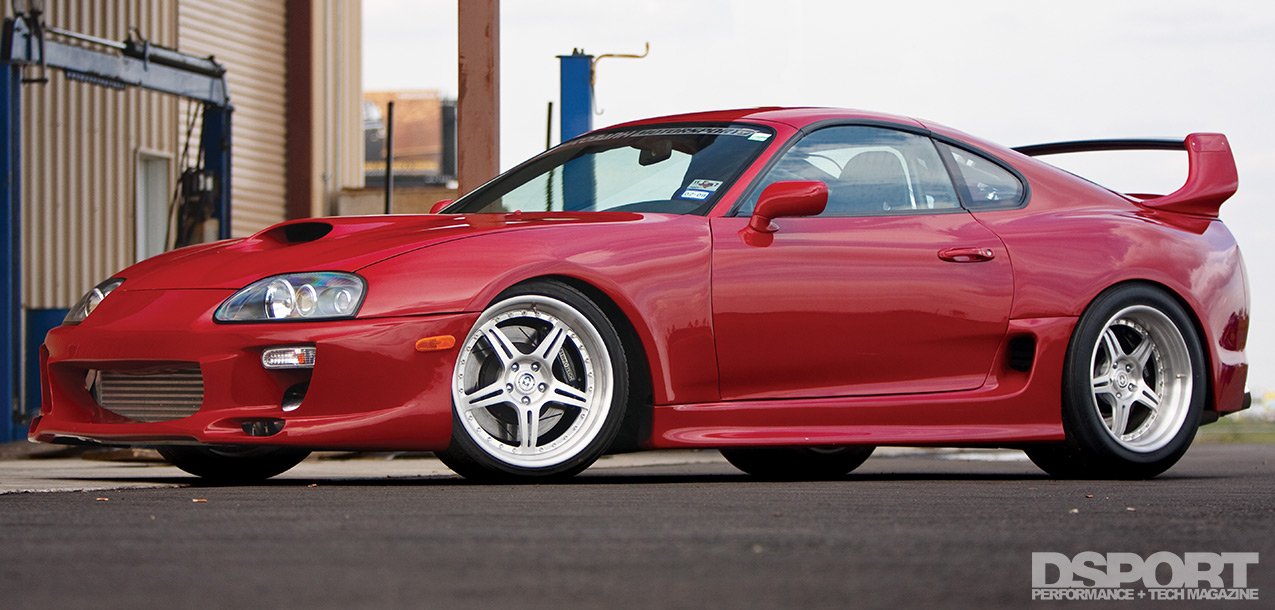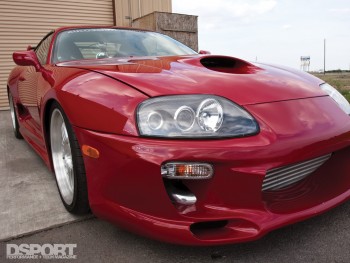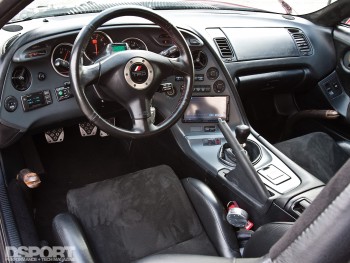Wizardry And Chemistry Combined
Now that the improved hardware was in place, it was time to bring the 2JZ to life. Expecting some lag from the big turbochargers, some chemical assistance was required to improve the ramp up. A Nitrous Express Direct Port nitrous-oxide injection system jetted to 300 horsepower was plumbed into the intake manifold. When activated, the system virtually eliminates turbo lag.
AEM’s Engine Management System (EMS) was chosen to orchestrate fuel delivery and ignition timing events. In the skilled hands of Tuning Concepts’ Justin Nenni, the tables were optimized for a peak boost pressure of 38.5 psi. With Big Red strapped to the rollers of ABM’s Dynojet 248X dynamometer, a staggering 1,622 horsepower was made at the wheels.
Building a high-horsepower engine for dyno competitions or strictly drag racing does not require too much in the way of cooling, since cool-down sessions can be executed between runs. However, Amit intended for Big Red to see the street and the occasional racetrack as well. Amit addressed temperature management at two sources. First, the factory radiator was replaced with a higher-capacity unit from Fluidyne. Second, rejecting heat from the engine oil was left to a GReddy 16-row oil cooler.
Ripping The Road
Making use of 1,600 horsepower on the road becomes a challenge. Improve- ments to the driveline, rolling stock and footwork are needed. To harness this wild herd of ponies, a Tilton Engineering Quad-carbon clutch was selected. This four-plate clutch transfers torque to the factory Getrag V160 transmission. The 6-speed Getrag spins an ABM driveshaft that delivers power to the 3.13:1 final drive and TRD limited-slip differential.
The LSD splits the power between the HRE Comp97 wheels mounted with Yokohama road racing slicks. Up front, the wells are filled with HRE rollers that feature Yokohama Advan Sport rubber. To keep the tires well planted, TEIN FLEX coilovers drop the ride height and center of gravity to improve handling and high-speed stability.
To reign in the horsepower, improving the Supra’s braking system became imperative. Hydraulic fluid flows through StopTech stainless-braided lines to the StopTech ST-60 six-piston calipers up front and the ST-40 four-piston calipers in the rear. The calipers squeeze StopTech pads that apply friction to the massive StopTech AeroRotors, shedding speed quickly.
Finishing Touch
The AAP Racing metal wide-body complements the Supra’s sleek lines, exag- gerating the fender flairs at all four corners. A STILLEN urethane bumper along with TRD side skirts and rear bumper complete the aero tuning package. The rear deck lid features a Rod Millen Motorsports carbon-fiber spoiler for added downforce over the rear wheels.
Inside the cabin, an ABM custom 8-point roll bar with swing-out door bars offers a degree of protection for the occupants which is especially important for a car at this horsepower level. Within the chromoly frame, ABM fitted a pair of Sparco Milano seats that work in conjunction with Simpson 5-point harnesses to secure the occupants in place. A TRD gauge cluster replaces the factory unit while an FJO wideband A/F meter displays the exhaust content from atop the steering column.
All Hail The Queen
Waiting patiently for the 2009 competitions to begin, Amit’s opportunity to showcase his build had finally arrived. At the TX2K9 Supra Nationals in Houston, Amit debuted Big Red at the Dyno Challenge on Friday, March 20. The standard had been set high, as the number to beat stood at 1,450 horsepower. As the last contestant of the day, Big Red made a pass without nitrous oxide only to fall short of the top number. It was time to turn on the system. Despite inadequate cool down time, Big Red still delivered 1,645 horsepower to the wheels to win the competition. Big Red earned the Dyno Challenge crown for 2009.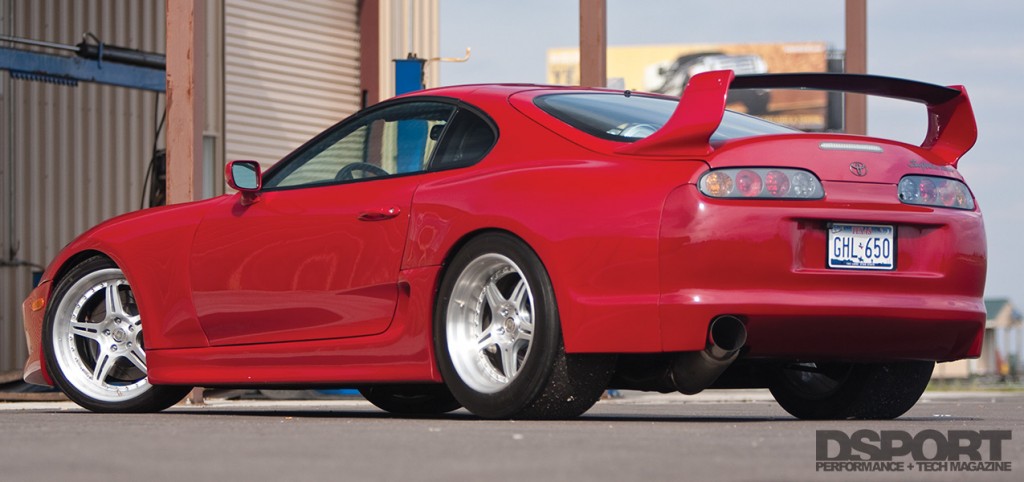
Going The Extra Mile
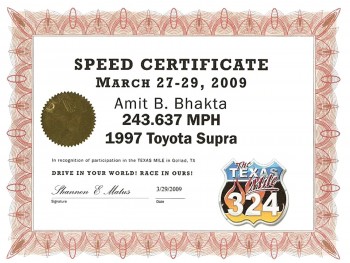 This queen did more than just sit on her throne. The weekend after Big Red won the Dyno Challenge, Amit had the Supra prepped for some high-speed action. At the Texas Mile, held at Goliad Industrial Air Park, Tommy Banh piloted Big Red to a best speed of 243.637 MPH with the boost pressure set to 34 psi and without the nitrous oxide system activated. This speed was only 2.5 MPH off the current record time. Amit note ad that while drag racing puts some wear and tear on an engine, it only lasts for seven seconds compared to the Mile, where sustaining high levels of horsepower over a longer period of time puts the engine through an incredible amount of stress and wear. For the cars that survive a day of competition at the Texas Mile, it is a testament to their builders and the engineers that designed the chassis, suspension and engine. Big Red represents one Supra that was built just right.
This queen did more than just sit on her throne. The weekend after Big Red won the Dyno Challenge, Amit had the Supra prepped for some high-speed action. At the Texas Mile, held at Goliad Industrial Air Park, Tommy Banh piloted Big Red to a best speed of 243.637 MPH with the boost pressure set to 34 psi and without the nitrous oxide system activated. This speed was only 2.5 MPH off the current record time. Amit note ad that while drag racing puts some wear and tear on an engine, it only lasts for seven seconds compared to the Mile, where sustaining high levels of horsepower over a longer period of time puts the engine through an incredible amount of stress and wear. For the cars that survive a day of competition at the Texas Mile, it is a testament to their builders and the engineers that designed the chassis, suspension and engine. Big Red represents one Supra that was built just right.


